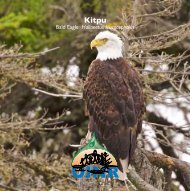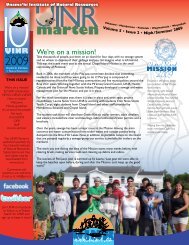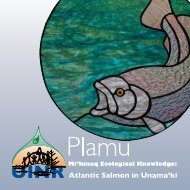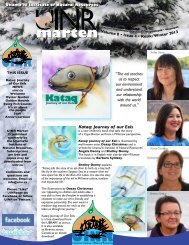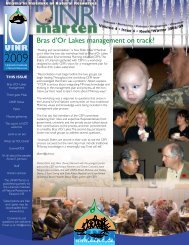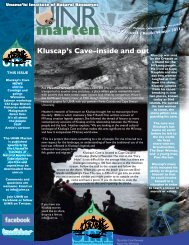Mi'kmaq Ecological Knowledge Distribution of Culturally Significant ...
Mi'kmaq Ecological Knowledge Distribution of Culturally Significant ...
Mi'kmaq Ecological Knowledge Distribution of Culturally Significant ...
You also want an ePaper? Increase the reach of your titles
YUMPU automatically turns print PDFs into web optimized ePapers that Google loves.
Miscellaneous Environmental Factors<br />
As with the environmental factor <strong>of</strong> Slopes, occasionally Talus Slopes was a favoured<br />
habitat for some <strong>of</strong> the plant species researched. Talus slopes are steep slopes <strong>of</strong> naturally<br />
occurring fractured rock with a wide range <strong>of</strong> particle size, ranging from large boulders to<br />
smaller loose stone and gravel. To map Talus Slope habitat, the original downloadable N.S<br />
Provincial electronic file p92003gs.shp, for surficial geology was utilized. The feature Unit <strong>of</strong><br />
Colluvial deposits has an accompanying description <strong>of</strong> “weathered and frost fractured rock<br />
and soils which form a blanket <strong>of</strong> material on steep valley walls, talus cone or rotational<br />
slump formed by either downward creep or mass movement <strong>of</strong> material.” The new layer,<br />
Export_CB_Surficial_Geology_Slope, was created from the Export_CB_Surficial_Geology.<br />
shp file, and Colluvial deposit polygons were assigned semi-transparent dark green tone as<br />
supporting habitat <strong>of</strong> Talus Slopes.<br />
Due to the steep sloping characteristics <strong>of</strong> Colluvial Deposits, Colluvial deposit polygons<br />
were also utilized in conjunction with raster mapping as representative <strong>of</strong> sloped<br />
topography, where there are gaps in the raster mapping used for the environmental factor<br />
<strong>of</strong> Slopes. Used in the context <strong>of</strong> sloped topography, Colluvial Deposit polygons were<br />
assigned a semi-transparent dark green tone as supporting habitat for some species <strong>of</strong><br />
plants.<br />
Ground Truths<br />
Using the environmental factors and the populated Habitat Tables, Grey Tone (Green<br />
Tone) mapping was produced for each individual plant species on the High and Medium<br />
and Lower Priority list. The cumulative effect <strong>of</strong> the overlain, semi-transparent, habitat<br />
layers produced darkened areas within the maps, indicating an accumulation <strong>of</strong> supportive<br />
habitat, and lighter areas <strong>of</strong> the maps indicate areas <strong>of</strong> less-supportive habitat, depending<br />
on the plant.<br />
Target points were then selected for field visits to verify if the targeted plant species could<br />
be located based on the Grey-Tone mapping. These target points were uploaded to GPS<br />
(Global Positioning System) for fieldwork crews. During travel to the target points and<br />
upon arrival, a scan for other Mi’kmaq culturally significant plants was conducted, and all<br />
plants found were recorded with a newly-placed GPS point taken in the field.<br />
Fieldwork was done in three stages. Initial fieldwork involved visiting areas indicated<br />
by Elders as gathering places for various plants. The next stage formed the bulk <strong>of</strong> the<br />
fieldwork and involved visiting individual target points to locate specific plant species.<br />
The later stage was an attempt to locate specific plant species that proved to be elusive<br />
in earlier fieldwork stages. Both the Elder first stage and second stage field visits were<br />
attended by a botanist to verify plant species.<br />
Although the field crews attempted to visit NewPage parcels, due to time constraints and<br />
a large geographic area, field crews in the second stage <strong>of</strong> fieldwork chose target point<br />
locations in close proximity to public roads.<br />
Field-recorded, ground truth points are supplemented by previously recorded locations<br />
<strong>of</strong> plant species derived from Cape Breton University (CBU) archives. The CBU locations<br />
were given in Latitude and Longitude coordinates that were rounded <strong>of</strong>f to degrees and<br />
minutes. These points are shown in the mapping for each plant where CBU data was<br />
available, along with a 60-second window box representing an area where the plant could<br />
have been located, assuming the coordinates were rounded down to the nearest minute.<br />
All ground truth points recorded in the field are shown with the Grey Tone mapping<br />
for each plant and include points recorded during Elder site visits, and the CBU archive<br />
location points. All Grey Tone maps for each plant species can be found in the appendices.<br />
11



